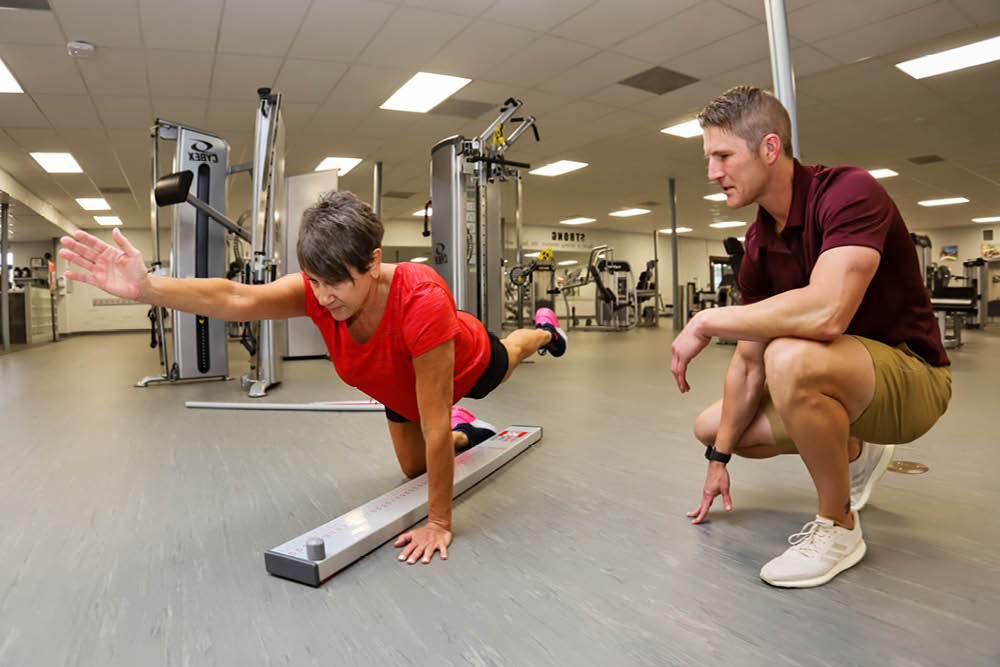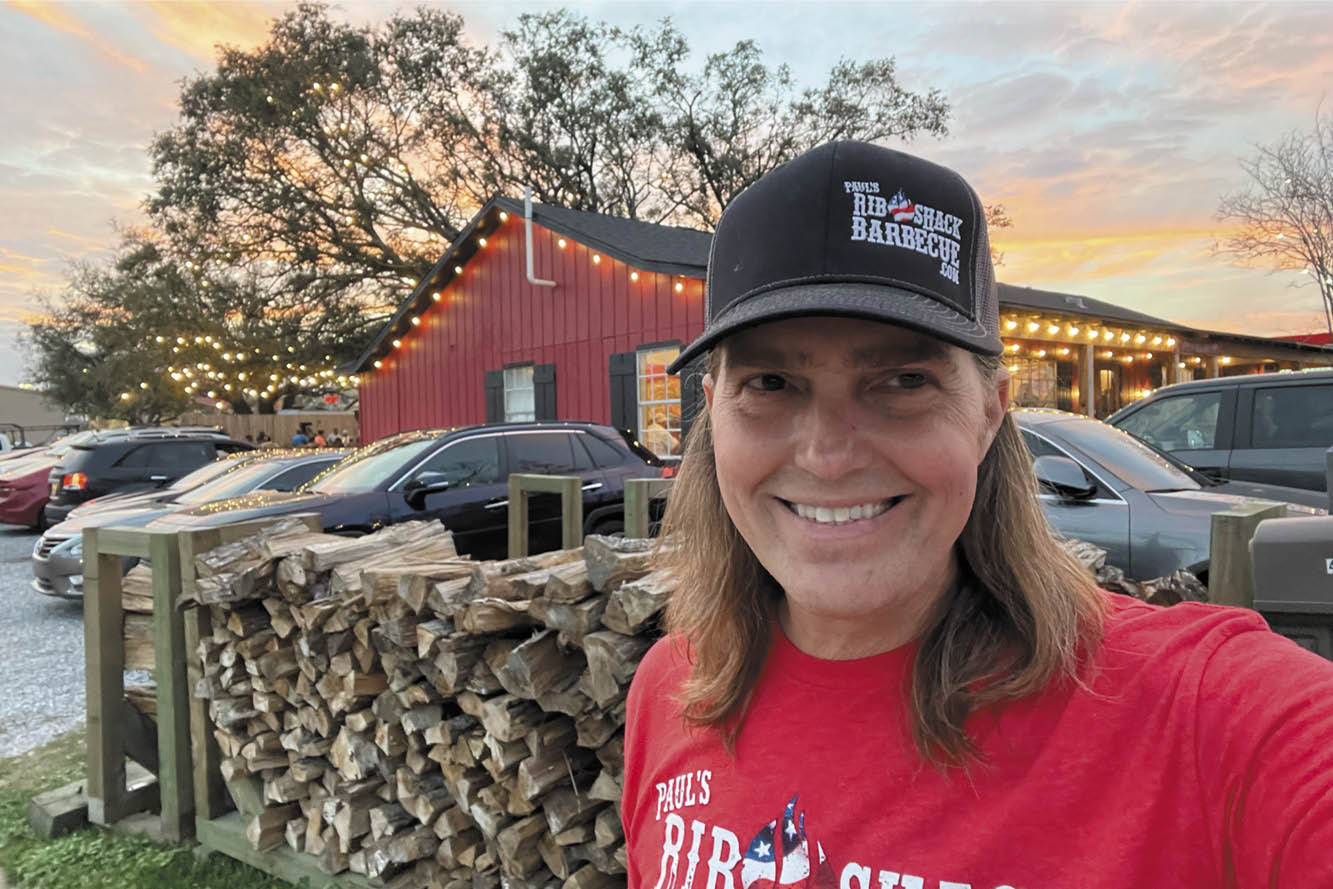
Measuring the Progress of Movement in Exercise
July 2021
First Person with Paul Pettefer Bishop of BBQ, Pitmaster, & Chief Fun Engineer
July 2021What does it mean to age well? What does that look like? Is it good physical or mental health? Financial security? Happiness and contentment?
Most experts would say all the above. Seniors today want their voices to be heard. They want to be relevant in their communities. So in this special section on Aging Well in 2021, we discuss issues that resonate with seniors today, including topics like where they might live in their more advanced years, sexual health, and the importance of planning their own funeral. We explore a variety of aspects on what it means to live life to the fullest.
Getting Older Doesn’t Need to be a Pain
by Kristy Como Armand
Baby Boomers — people born between the years 1946 and 1964 — are getting older. Approximately 10,000 Americans turn 65 each day. By 2030, all Boomers will be at least age 65.
As a group, Baby Boomers are living nearly twice as long as previous generations, and for the most part, are remaining much more active. And while this on-the-go population segment may not want to slow down, a wide range of aches and pains is starting to cramp their style. In a recent study, more than two out of three Boomers said they suffer from muscle and joint pain at least once a week.
However, this generation is less resigned to simply accept injury and pain as an inevitable part of aging, and, according to William Lowry Jr., MD, physical medicine and rehabilitation specialist with the Center for Orthopaedics, they don’t have to. “We often see older adults who want to keep doing all the things they did when they were younger but find themselves struggling due to chronic pain. Fortunately, we have many more options to offer people who want to maintain an active lifestyle as they age.”
Dr. Lowry says the original source of pain is typically just the natural wear and tear that occurs to joints over time. “As you get older, your joints start to show the signs of years of use, just like anything else, but that doesn’t necessarily mean you have to stop using them.” He explains that Boomers often unknowingly make their problem worse by cutting back on their activities when they experience joint pain. “Their knee or back hurts after physical activity, so they stop doing that activity. This results in a loss of muscle strength, decreased range of motion, reduced circulation to the area, and stiffness. So the next time they need to exert that part of their body, they experience more pain and stiffness due to inactivity. Pretty soon, that knee or back is painful any time they move. It’s a vicious cycle that can quickly lead to an extreme reduction in activity and chronic pain.”
The good news is that Baby Boomers do not have to live with the pain. “There is so much we can do to provide pain relief. Many Boomers are reluctant to seek help because they feel surgery or joint replacement is their only option. But that is definitely not the case. We have an arsenal of non-surgical interventions that can often eliminate – or at least delay – the need for surgery for joint pain,” says Dr. Lowry.
He says the first step is a comprehensive physical exam to assess functional status, which helps identify the source and cause of the pain. “With older adults, it is very common for the muscles that stabilize and support the joint to be weak. This can lead to instability around the joint, which can worsen arthritis and pain. If we can correct that with a program of physical therapy and strength training, that patient can not only be pain-free, but also be able to return to a more active lifestyle.”
Other non-surgical treatment options may include over-the-counter or prescription medications, injections, heat and cold therapies, electrotherapies, massage, bracing, rehabilitation programs, nutritional recommendations and therapeutic exercise.
“The treatment is determined based on each individual’s unique situation – their pain level and functional capacity. When it comes to pain management in these cases, there is no ‘one-size-fits-all approach,” says Dr. Lowry.
To schedule an appointment for joint pain or any other musculoskeletal problem, call Center for Orthopaedics at 721-7236 or visit www.centerforortho.com.
Top 6 Concerns of Seniors & How to Manage Them
by Angie Kay Dilmore
Over the past century in the United States, the proportion of persons aged 65 years or older increased more than threefold, from 4.1% to 12.9%, according to the American Journal of Public Health. Baby Boomers (born between 1946-1964) continue to set new aging standards, drive public policy, and impact our culture in diverse ways. And there’s much to feel positive about. As the second-largest living adult generation (their children, the Millennials, are the largest), Boomers are healthier and live longer than previous generations, primarily due to the many medical advances during their lifetime. Yet that’s not to say they don’t have a care in the world. Seniors have plenty of valid concerns to ponder.
Here are six issues that occupy space in the average senior’s thoughts:
- Health Matters
In addition to health insurance and drug cost concerns, various diseases (and how to prevent them) are at the forefront of elderly minds. Alzheimer’s disease and dementia, heart disease (leading cause of death for people over age 65), cancer, diabetes, mental health issues, vision and hearing loss, sleep disorders, and injuries due to accidents (falls are the leading cause of injury among older adults) . . . these illnesses and other issues can be major worries. Family history and age can play roles in the risk for many medical conditions. However, numerous health problems can be prevented or the progression slowed by making smart, healthy choices and maintaining regular doctor visits.
Healthy lifestyle choices that can help or prevent many illnesses include:
- Eat a balanced diet – Lots of fruits and vegetables; whole grains; lean, unprocessed meats; dairy products in moderation; and limited sweets.
- Physical activity – The CDC recommends 150 minutes of moderate-intensity aerobic activity per week and strength training twice a week.
- Social interactions – Five percent of older adults are home bound, rarely leaving the house except for important medical appointments. More than 40 percent of seniors regularly experience loneliness, according to a University of California, San Francisco report. Studies show that married people tend to be healthier and live longer, and a strong social life has been linked with many health benefits, like less risk of depression and longer life span. But a new study reported by Harvard Health suggests that interacting with a wide range of people may offer even greater benefits. Consider taking a class at a local college. Or volunteer for a local charity, which provides not only social interaction, but a sense of purpose, as well.
- Restorative sleep – Most things change as humans age, including sleep patterns. A whopping 46% of adults age 65 and older have trouble falling asleep and sleeping well through the night regularly. Hormonal changes, stress, chronic pain, certain illnesses, and sensitivity to environmental factors can be blamed. But quality sleep is critically important. Adults need seven to eight hours of restful sleep each night. To improve sleep quality, maintain a consistent sleep schedule (go to bed and arise at the same time each day). Avoid caffeine, alcohol, sugar, and spicy foods close to bedtime. Stop the use of electronics, ie cell phones and tablets, an hour or two prior to sleep. If poor sleep persists, see your doctor.
2. Financial Wellness
As seniors are living longer, historical models of retirement have become outdated. Financing the retirement years today may look different than a decade or two ago. Savings, pensions, social security payments . . . so many factors come into the equation.
The key is to have a sound financial plan. If you are concerned about funding your retirement and living comfortably, consider these suggestions:
- Consider a part-time job. Depending on the nature of the position, not only will you bring in added income, but you’ll get out of the house and socialize with people.
- Down-size your home and possessions. As people age, they begin to realize that less is easier to manage, physically, mentally, and financially. The fewer “things” you need to maintain, the less cost and stress.
- Consult with a financial advisor for guidance. It doesn’t matter if you have a lot of resources or less to work with, getting the advice of a professional can put you on the right path to your best living.
3. Socio-Political Concerns
According to a Pew Research study, persons ages 65 and older made up 23% of the 2020 electorate. But because older citizens are more likely to vote than younger generations, their sway can be even more significant. Sure, seniors are concerned about the state of socio-political matters that affect them directly, such as Social Security and Medicare, but they are even more concerned about the world their children and grandchildren will inherit. They want to know what the future holds for our country, our democracy, our environment . . . and they want to know how they can make a difference.
- Continue to exercise your right to vote.
- Volunteer to work at polling stations or for candidates’ campaigns.
- Contact your state and federal representatives and express your opinions. It is their job to serve you.
- Join advocacy groups that promote causes you care about.
- 4. Keeping Up with Technology
- Whether it’s FaceTime with the out-of-state “kids”, a text to your daughter to pick up some eggs on her way to visit, learning how to work the new Smart TV, getting in on the video game fun with the grandkids, clipping coupons on the grocery store app, paying bills online, keeping up with friends on social media, or sending a letter to the newspaper editor via email, there is no getting around the fact that technology is a part of our lives, for better or worse. And old dogs CAN learn new tricks!
- Take a Leisure Learning computer class at a nearby college.
- Check with your local senior center for tech tips.
- YouTube has tutorials on basically everything.
- Visit your library for how-to books.
5. Housing Options
Maintaining independence is high on most seniors’ list of concerns. The majority of older adults state a preference to “age in place” yet one third of people over age 65 need assistance with at least one activity of daily living (e.g. eating, bathing, dressing). But today’s seniors have a wide variety of housing options, depending on the needs of the individual or couple.
- A first step is often downsizing to a smaller, single-floor home, which is easier to maintain and navigate.
- If you wish to age in place, modifications can be made to your home that facilitate this option. Home care aides can visit to help you with activities of daily living and light housework.
- Assisted living facilities usually provide small apartments, meals, housekeeping, transportation, fun activities, and companionship.
- If none of the above are options, skilled nursing facilities and memory care centers provide a higher level of care.
6. End-Of-Life Dtails
Few people want to talk about end-of-life concerns, but there is peace of mind knowing your affairs are in order. Plan early and be ready for anything because life can be unpredictable.
- Arrange a meeting with your loved ones and have the important conversations. This may seem hard, but they need to be aware of your wishes so they can carry them out.
- Meet with your lawyer and either update or create a will and an advanced directive for medical care preferences. Also, name your executor and financial and medical power of attorneys.
- Organize a binder with everything your loved ones will need to know when the time comes – financial, insurance, and utilities account information and account numbers, PIN numbers, passwords to everything, addresses and phone numbers, a list of all subscriptions, any special requests, and everything you can think of that will help them take care things when you aren’t able.
Maintain a Vibrant Smile as You age
One of the secrets to aging well is taking care of your smile. Your teeth and mouth endure a lot during your life, and proper attention and care can help slow the hands of time. Here are a few tips from Robinson Dental Group to help you maintain a vibrant, lasting smile.
Skip the Soda and Sugary Foods
Sugary, acidic foods and beverages damage your enamel – the protective coating on your teeth – making your teeth more prone to erosion and cavities. Try to limit wine, sodas, citrus fruit and the like when you can. If you do have one of the above, rinse your mouth with water right after, then brush about 30 minutes to an hour later. Look for foods/drinks that support your dental health such as calcium-rich milk, cheese, and nuts.
Grab the Toothbrush . . . and the Floss
Brushing for two minutes, two times a day is a no-brainer, but flossing? It’s equally as important as brushing and should be done at least once a day. Brushing and flossing serve the same purpose – removing plaque. However, doing only one or the other leaves a significant portion of your mouth with plaque buildup. While flossing may seem less important, the difficult-to-reach spots it cleans between your teeth and underneath your gums are the spaces that harbor the most destructive bacteria. Bottom line: brush AND floss to prevent plaque buildup and gum disease.
Keep Your Appointments
The easiest way to keep a healthy smile is by visiting your dentist every six months for a cleaning. Regular dental appointments ensure that your oral health is on track and can help you identify problems early.
Brighten & Whiten
Our smiles naturally yellow with age, but that doesn’t mean they have to stay that way. There are several options for whitening your teeth, whether or not they are sensitive. In-office remedies, such as the one-visit GLO professional whitening treatment, uses light therapy to help you achieve as bright of a smile as you want with as little sensitivity as possible. Bleaching trays with whitening gel are an at-home solution. What’s the difference between professional dental whitening and store-bought kits? Professional teeth whitening contains high concentrations of whitening gel that is far more potent than what you’ll find in a store or kits purchased online. Plus, a dentist can monitor the process every step of the way to ensure your smile is just as bright and white as you would like it to be.
Consider Other Dental Treatment Options
Whether you have smile lines that you want to decrease or a chipped tooth that needs to be fixed, there are in-house treatments to enhance or restore your smile such as veneers, implants, Invisalign®, or even Botox® or Juvéderm®.
For a smile makeover, veneers allow you to choose the exact color, size, and shape that you want your teeth to be. Your dental team will ensure each tooth looks uniform yet natural. Invisalign® clear aligner therapy is a relatively quick and easy alternative to braces that can give you that straight smile you’ve been dreaming of. Botox® and Juvéderm® can help reduce unwanted lines and wrinkles around your eyes, nose and mouth, as well as give you youthful volume in the lips and cheeks.
To restore your smile, composite fillings are an easy and simple way to repair teeth that have been chipped, broken, or damaged by tooth decay – and they can be made to match your natural tooth color, so they’re virtually undetectable. If you have one or more missing teeth, implants may be the perfect solution. They are durable, long-lasting tooth replacements. Another option is natural-looking partial or full dentures for individuals who have lost a significant amount or all of their teeth.
For more information about Robinson Dental Group, please visit www.robinsondentalgroup.net or call us at 337-474-3636.
Keeping the Passion Alive
Just because your body is aging, doesn’t mean that your sexual health should be ignored. Your body changes as you age, but what shouldn’t change is that people deserve to be sexually healthy and enjoy their sex life as much as they can. In fact, issues with your sexual health can be a sign or symptom of a greater problem that should be addressed with a physician.
Memorial Medical Group Family Medicine Specialists Ben Groves, DO and Kira Groves, DO have laid out a few areas to keep in mind if you are experiencing a decrease in sexual desire or function as you get older:
Post-menopausal women:
The natural cycle for women eventually leads to menopause. This means a woman’s body decreases in estrogen and progesterone production.
Fertility ceases, and this may or may not lead to a decrease in sex drive. It does, however, over time lead to thinning and dryness in the vaginal tissues. This can cause pain or difficulty enjoying sex. This is treatable with lubricants and pelvic physical therapy.
Chronic pain:
Chronic pain of any kind can decrease energy and sex drive. Side effects from medications for chronic pain may impact your sex drive, as well.
Other medications can be added to deal with those side effects, but the goal is not to decrease the quality of life. A doctor can put together a good holistic plan to treat pain and improve sexual health.
After cancer or cancer treatment:
The overall cancer journey can impact sex life and intimacy with your partner.
The mental load and symptoms from cancer and treatment can temporarily decrease desire for sex. In some cases one may regain your desire for sex after the treatment is over.
In other situations, medications or additional treatments may be needed to return to normal. For men and women, treatments such as radiation can greatly impact nerve endings. Scar tissue can form in the vagina for women.
Therapy is available to regain nerve function and improve sexual function. For women there are tools available to help dilate the vaginal region and regain sexual function, especially after radiation treatments to the pelvic or abdomen regions. All cancer patients may benefit from medical or psychological therapy to help with any personal issues with body image and confidence.
Heart Disease:
Disease in your heart means that you probably have disease in other parts of your vascular system. A major component of sexual function is blood flow, and if the blood flow is poor in the genital areas sexual function and enjoyment may be difficult. Treating cardiovascular health and preventing heart disease can help with sexual function as you age.
Diabetes:
Neuropathy causes nerve damage in all areas of the body, not just in your feet.
By the time this begins, nerve functions are not usually able to come back after being lost. Treating your diabetes properly can prevent this affecting your sexual function as you age.
Depression:
In the older population, depression seems to go unnoticed and untreated. Lack of sexual function may be one of the signs of depression. Lack of desire in regular daily activities, fatigue, and inability to sleep is not necessarily normal. When depression is treated, desire for sex may come back.
Promising Advances in Memory Care Found at The Verandah Assisted Living & Memory Community in Lake Charles
According to the Alzheimer’s Association, in 2021 more than six million Americans over age 65 are living with Alzheimer’s dementia. While that number is quite staggering, the good news is that memory care therapies continue to improve, offering hope to those affected by Alzheimer’s disease as well as other memory-related disorders.
Leslie Von Der Ahe, RDN, LD, LNFA, Executive Director at The Verandah Assisted Living and Memory Care Community in Lake Charles, says her residents are already benefitting from many of these leading-edge therapies available at her community.
Located in the beautiful neighborhood of Graywood, The Verandah combines Person-Centered Care with a robust Life Enrichment Program that embraces six Pillars of Wellness: physical engagement, sensory stimulation, spiritual support, social connection, intellectual discovery, and emotional expression.
The pioneering Life Enrichment Program draws from a philosophy rooted in the Montessori Method, which was initially developed for early childhood education but modified to provide sensory stimulation, encourage cognitive stimulation and build on existing social skills among seniors with memory-related diseases.
“By modifying the Montessori method to honor the age and experiences of our Memory Care residents, we are able to ease the symptoms of dementia-related disease to help enrich their daily lives,” said Von Der Ahe.
The Verandah also features an innovative Sensory Spa, a new therapy that can reduce tension, agitation, anxiety, depression, and anger, which are common behavioral side effects in seniors suffering from Alzheimer’s and other dementias. Residents enjoy sensory stimulation that activates one or more of the five senses (taste, smell, vision, hearing, and touch) with the goal of evoking positive feelings.
“By planning meaningful, stimulating activities and considering our residents’ unique interests, we can create personal experiences in our custom Sensory Spa and make a significant difference in our residents’ lives,” continued Von Der Ahe.
Residents also benefit from a revolutionary Virtual Reality (VR) therapy that helps promote joyfulness and calm. The program features state-of-the-art VR headsets and several special VR software programs that allow residents to choose from a variety of experiences such as traveling to virtual locations, cooking classes, performances, and more. Along the way, many residents uncover distant memories, which in turn reduces stress, anxiety and aggressive or responsive behaviors.
Nutrition also plays a vital role in memory care. The Verandah’s all-day dining program is based on the MIND Diet, developed at Rush University, and shown to lower Alzheimer’s risk by about 35 percent for people who followed it moderately well and up to 53 percent for those who adhered to it rigorously. Both nutrient-rich and delicious, these meals feature green, leafy vegetables, other non-starchy vegetables, berries, nuts, olive oil, whole grains, fish, beans, and poultry, while avoiding ingredients such as butter and margarine, cheese, red meat, fried food, and sweets.
“Our top priority at The Verandah is and always has been the health, wellbeing and safety of our residents,” said Von Der Ahe. “We continue to research and implement a number of innovative therapies that can help our seniors with memory-related disease thrive.”
For more information, contact Leslie Von Der Ahe, leslie.vonderahe@sunshineret.com, (337) 478-9500.
Upcoming Trends in Assisted Living
Loe Hornbuckle, CEO Sage Oak Assisted Living & Memory Care, got into the elder care business because he says it was broken. He didn’t know how it was broken, just that it didn’t work like it was supposed to. “I lost my father in 2014 and he hadn’t received the care he deserved. I couldn’t bear the idea of other families dealing with what happened to me and my family, so I decided to change careers and start Sage Oak.”
Hornbuckle says the COVID-19 pandemic brought to light many of the current flaws in long-term elder care, and the concept is prime for “disruption” which will lead to major industry reform. He feels the following changes are on the horizon:
Smaller facilities will become more common.
While every state is different, in Texas and Louisiana, a facility with 16 beds or less is considered small. According to a June 2020 article in Senior Housing News, small-house senior living may be well suited to handle the disruptions of the COVID-19 era. This may help boost the model’s popularity moving forward, but the industry will first need to overcome obstacles regarding the way these communities are developed, financed, and licensed.
Staff to resident ratios will become more important than amenities.
COVID-19 put a huge strain on staffing in an already staffing-challenged industry. With ratios of 1-12 or 1-15, many facilities lack the adaptability and lower margin of error as that of a facility with, for example, a 1-4 ratio. “Of course, this was always true, and something that industry insiders have known for years, but the pandemic made the residents and their families very aware of how important staff to resident ratios truly are,” says Hornbuckle.
Technology will finally fulfill its promises to the industry.
Hornbuckle says technology hasn’t really made much of an impact on elder care, especially when compared to the lofty claims made by the tech industry. His friend, Dr. Bill Thomas, founder and chairman at Minka and author of Aging Magnificently, says, “Gero-technology has not yet produced a breakout product, but one thing that improved during COVID-19 was Telemedicine.”
“Sage Oak of Lake Charles opens this month and brings to Southwest Louisiana the forward-thinking disruptions to systematic and structural flaws present in some long-term care facilities,” says Jeremy Fruge, Executive Director at Sage Oak. “In five independently licensed, purpose-built, boutique settings, Sage Oak’s unique care model encompasses industry-leading staffing ratios of 1:8 in Assisted Living and 1:5 in Memory Care; purpose-designed homes laid out with clear sight lines and no long hallways to help reduce falls; and delicious, nutritious, chef-inspired meals.”
Sage Oak is located at 5650 Weaver Road in Lake Charles. For more information, contact Executive Director Jeremy Fruge at infolakecharles@thesageoak.com or call 337-563-0073.
Your Memorial Wishes: A Final Gift for your Family
by Haley Armand Tarasiewicz
Few of us want to think of how our life will end, or how things will continue after we’re gone. But one of the most meaningful gifts you can give your family is a plan for your memorial service. When your wishes are left behind, it eases the burden on loved ones who will be expected to make decisions and answer questions about how to proceed in the hours and days immediately after your death.
“It’s about providing peace of mind to you, but most importantly, to those who are most important to you,” says Andy Hankins, licensed funeral director with Johnson Funeral Home. “When you plan your service beforehand, it makes things much easier for your family, who will already be going through a difficult time. We see the difference this makes for the families. Losing and saying a final farewell to a loved one is one of the most stressful situations a family faces. Having to make decisions about funeral and burial arrangements during this time just adds to that stress. Putting a plan in place ahead of time eliminates this burden.”
What would your loved ones’ lives be like if you died and hadn’t properly prepared your estate and legal documents? Survivors also are often left to make decisions about funerals or memorial services while they are still grieving. Just 34 percent of people over age 50 have planned for their funeral or burial, according to the AARP. Meanwhile, funerals come with a hefty price tag that keeps rising, with the average cost in 2020 at $9,135, according to the National Funeral Directors Association.
According to Hankins, your wishes can be as personalized and detailed as you want.
“Instead of approaching it as a sad or morbid task, think of it as a positive thing—a gift to your family. Think about how you want your memorial service to look or feel. Most of us would prefer that people celebrate our lives rather than mourn our deaths. If so, consider how you’d like your loved ones to do that,” Hankins said.
A few things to consider:
Music and songs. Music is typically an essential element of a service. What do you want performed at your service? Something uplifting, that celebrates life? Something nostalgic from your past? Your favorite song, perhaps?
Traditions. If you have specific traditions you want to follow, make sure that’s clear. “Don’t assume your family knows,” Hankins says. “Discuss it with them so you can be sure they know your wishes and they won’t have to debate the decisions with each other.”
Readings. If you desire a faith-based service, you may wish to include your favorite scripture or readings,” says Hankins. “Those who prefer a more secular service could choose inspirational readings and personal philosophies.”
Eulogists. Is there someone specific you’d like to deliver your eulogy? If so, are there key aspects of your life you want that person to talk about?
Visitation and service. Do you want a viewing, visitation or wake before your service? “As for the service itself, you may want to consider whether you’d prefer a funeral service, memorial or graveside,” says Hankins.
Who and where. Who do you want to officiate, and where?
Donations or gifts. “Many people prefer that the attendees give a donation in their honor, rather than flowers,” Hankins says. “If that’s the case, make those wishes clear.” Once you have all your wishes documented, make sure your family or loved ones know where to find them. Keep the document in a safe and secure place, preferably with your other important papers.
“You can also arrange payments beforehand, so no one is left with a financial burden,” Hankins adds. “This can also be a huge cost-savings for your family. Pre-paying for your funeral years ahead of time allows you to lock in today’s lower costs.”
Hankins says there are numerous options for pre-arrangement policies and that is something his staff can assist with, along with other funeral pre-planning services.
For more information on funeral pre-planning or to schedule a free consultation, call Johnson Funeral Home at (337) 478-8687.






